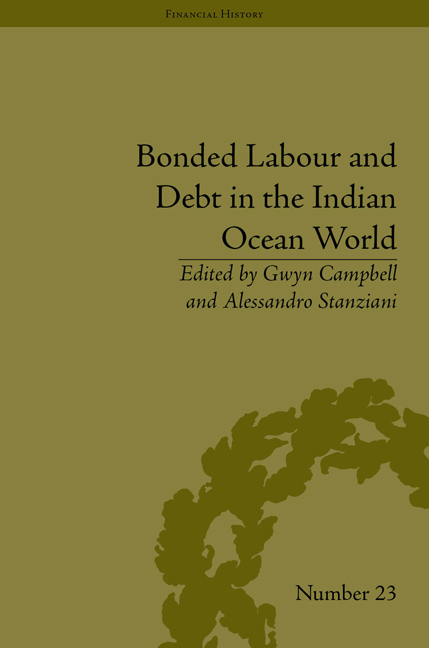Book contents
- Frontmatter
- Contents
- Acknowledgements
- List of Contributors
- Introduction
- 1 Debt and the Coercion of Labour in the Islamic Legal Tradition
- 2 Debt, Pawnship and Slavery in Nineteenth-Century East Africa
- 3 Debt and Slavery in Imperial Madagascar, 1790–1861
- 4 Credit and Debt in the Lives of Freed Slaves at the Cape of Good Hope: The Case of Arnoldus Koevoet, 1697–1735
- 5 Debt, Labour and Bondage: English Servants versus Indentured Immigrants in Mauritius, from the Late Eighteenth to Early Twentieth Century
- 6 Ransom, Escape and Debt Repayment in the Sulu Zone, 1750–1898
- 7 Debt and Slavery among Arabian Gulf Pearl Divers
- 8 The Political Economy of Debt Bondage in Contemporary South India
- 9 The Name of the Slave and the Quality of the Debt: When Slaves Are Not Debtors and Debtors Are Not Slaves in the Family Narrative of a Filipina Comfort Woman
- 10 Two Bonded Labour Emigration Patterns in Mid-Nineteenth-Century Southern China: The Coolie Trade and Emigration to Southeast Asia
- 11 Debt Slaves in Old Korea
- 12 The Debt-Servitude of Prostitutes in Japan during the Edo Period, 1600–1868
- Notes
- Index
7 - Debt and Slavery among Arabian Gulf Pearl Divers
- Frontmatter
- Contents
- Acknowledgements
- List of Contributors
- Introduction
- 1 Debt and the Coercion of Labour in the Islamic Legal Tradition
- 2 Debt, Pawnship and Slavery in Nineteenth-Century East Africa
- 3 Debt and Slavery in Imperial Madagascar, 1790–1861
- 4 Credit and Debt in the Lives of Freed Slaves at the Cape of Good Hope: The Case of Arnoldus Koevoet, 1697–1735
- 5 Debt, Labour and Bondage: English Servants versus Indentured Immigrants in Mauritius, from the Late Eighteenth to Early Twentieth Century
- 6 Ransom, Escape and Debt Repayment in the Sulu Zone, 1750–1898
- 7 Debt and Slavery among Arabian Gulf Pearl Divers
- 8 The Political Economy of Debt Bondage in Contemporary South India
- 9 The Name of the Slave and the Quality of the Debt: When Slaves Are Not Debtors and Debtors Are Not Slaves in the Family Narrative of a Filipina Comfort Woman
- 10 Two Bonded Labour Emigration Patterns in Mid-Nineteenth-Century Southern China: The Coolie Trade and Emigration to Southeast Asia
- 11 Debt Slaves in Old Korea
- 12 The Debt-Servitude of Prostitutes in Japan during the Edo Period, 1600–1868
- Notes
- Index
Summary
In July 1928, a pearl diver named Marzuq bin Mubarak fled from Sharjah to Bahrain and presented himself at the British Political Agency. He came seeking a manumission certificate – a document verifying his freedom from slavery and establishing his right to find independent employment with pearling captains. By his own account, Marzuq was a slave. His parents had been brought from Zanzibar to Sharjah where they worked as slaves in the house of one Khalifa bin Rashid. Both of Marzuq's parents had died when he was about five years old, and he grew up working in his master's house, eventually working for him as a pearl diver. The agency staff who recorded his story noted that he looked about twenty-two years old, appeared to be of Zanzibari origin and spoke Arabic. According to Marzuq, his master, Khalifa, was a cruel man who ill-treated him and beat him with sticks. At the end of the most recent pearling season, Marzuq fled Sharjah for Bahrain to seek a new life, and hoped that the certificate he would receive from the British government would allow him to live freely and work for himself instead of a cruel master.
Following standard procedures, the Political Agency in Bahrain forwarded Marzuq's account to Sharjah and requested that the local Residency Agent there, Isa bin Abdul Latīf, enquire into the truthfulness of his testimony.
- Type
- Chapter
- Information
- Bonded Labour and Debt in the Indian Ocean World , pp. 103 - 118Publisher: Pickering & ChattoFirst published in: 2014



